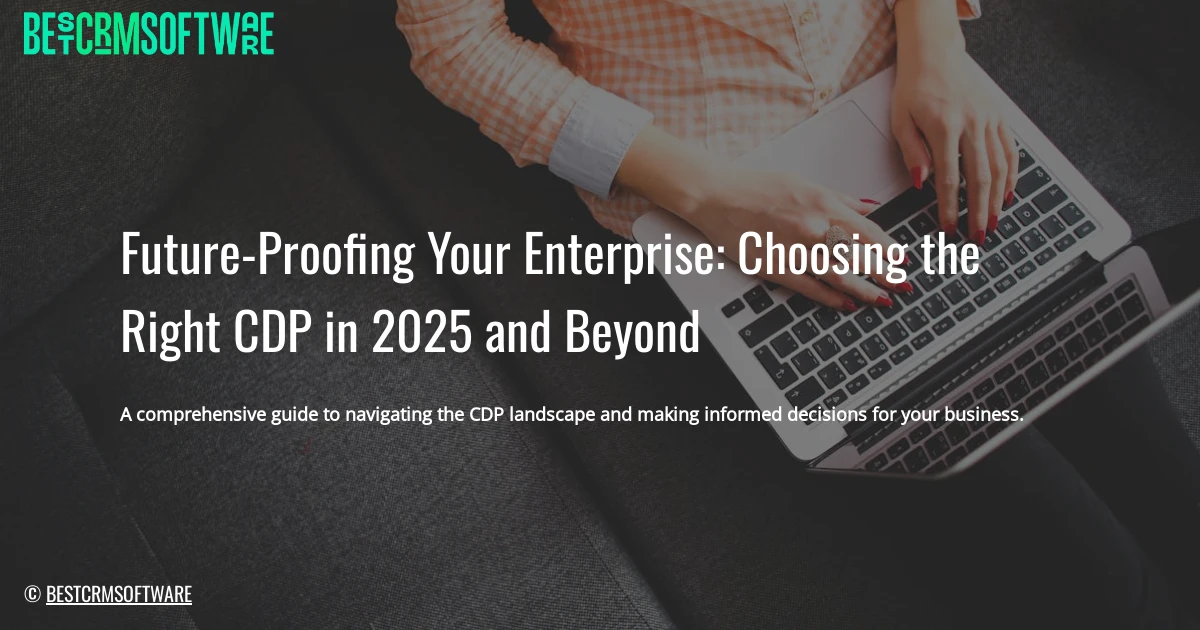A comprehensive guide to navigating the CDP landscape and making informed decisions for your business.
The Evolving Landscape of Enterprise Data
The landscape of enterprise data is in a constant state of flux, driven by an ever-growing volume, variety, and velocity of information. As businesses embrace digital transformation and strive for data-driven decision-making, understanding this evolution is crucial for future-proofing your enterprise.
Understanding the evolving data landscape and its impact on enterprise decision-making. The sheer volume of data being generated is overwhelming, with estimates projecting a global data volume of 175 zettabytes by 2025. This includes not only traditional structured data but also unstructured data sources like social media feeds, website traffic, sensor readings, and more. This shift compels organizations to adapt their data management and analysis capabilities, requiring sophisticated tools and solutions that can handle diverse data sources and provide real-time insights.
Defining your specific business goals and aligning CDP capabilities with future needs. The increasing complexity of the data landscape requires businesses to have a clear understanding of their specific needs and objectives. This involves aligning business goals with the capabilities of a CDP, ensuring it can cater to current and future demands. Organizations need to assess their future needs – anticipating new data sources, evolving business models, and evolving customer expectations. A CDP’s scalability, adaptability, and flexibility will be crucial in meeting these evolving requirements.
Exploring key industries leveraging CDPs for competitive advantage in 2025. Various industries are already experiencing the transformative impact of CDPs. Here’s a glimpse into how different sectors are harnessing their power for competitive advantage:
- Retail: CDPs help personalize customer experiences, optimize marketing campaigns, and forecast product demand.
- Financial services: CDPs enable fraud detection, customer segmentation for personalized offerings, and improved risk management.
- Healthcare: CDPs streamline patient journeys, enhance care coordination, and personalize treatment plans based on patient data.
- Manufacturing: CDPs improve supply chain efficiency, optimize production processes, and personalize customer engagement based on their preferences.
As data becomes more central to every business operation, CDPs will play an even more critical role in unlocking the potential of this data to drive growth and innovation.
The key lies in actively engaging with the evolving landscape of data and aligning your CDP strategy with future business needs to truly future-proof your enterprise.
Data Centralization: Building a Unified Customer View
The ability to deliver truly personalized customer experiences hinges on having a complete and accurate understanding of each individual. In the wake of evolving privacy regulations and the rise of first-party data, data centralization emerges as the cornerstone of this strategy.
1. Deep Dive into First-Party Data: The Cornerstone of Personalized Experiences
Gone are the days of relying solely on third-party cookies and tracking. First-party data – information directly collected from customers through website interactions, surveys, and customer relationship management (CRM) systems – is now the golden standard.
- Direct Relationships Matter: First-party data allows for direct relationships with customers, enabling deeper insights into their preferences, behaviors, and purchase history.
- Enhanced Personalization: With first-party data, businesses can personalize marketing messages, product recommendations, and customer service interactions with unmatched accuracy.
- Greater Control and Privacy: This approach empowers businesses to adhere to evolving privacy regulations, ensuring transparency and respect for customer data.
2. Strategies for Unifying Customer Data from Disparate Sources
Building a single customer view requires breaking down data silos and stitching together data from various sources:
- Customer Relationship Management (CRM): The heart of customer data, CRMs hold information about interactions, demographics, and purchase history.
- Web Analytics: Data on website behavior, user journeys, and engagement metrics provides a digital footprint of customers.
- Marketing Automation Platforms: Track customer engagement with marketing campaigns, email opens, and click-through rates.
- Social Media: Understand customer sentiments, brand mentions, and online interactions across various social platforms.
Integrating data from these sources is crucial. This can be achieved through:
- Data Transformation Tools: Streamline data cleansing, formatting, and enrichment to ensure consistent and reliable information.
- Data Lake and Data Warehouse Solutions: Centralized repositories for storing vast quantities of data from different sources.
- Real-Time Data Pipelines: Enable continuous data flow and updates, ensuring your customer view remains current.
3. Maintaining Data Integrity: Robust Data Governance Policies
As you centralize data, implementing robust data governance policies becomes vital. This involves:
- Data Access Controls: Establish strict guidelines for user access to sensitive customer data.
- Data Quality Standards: Define and maintain accurate, consistent, and reliable data. Implement data quality checks to ensure the integrity of your customer profiles.
- Privacy Compliance: Adhere to relevant regulations such as GDPR and CCPA. Develop strong data protection and consent mechanisms to safeguard customer privacy.
- Data Security Measures: Employ robust security measures to protect data from unauthorized access and potential breaches.
By diligently embracing data centralization with a focus on first-party data, implementing data unification strategies, and establishing stringent governance policies, you equip your enterprise with the insights and capabilities to drive personalized customer experiences in the evolving digital landscape.

© Ruslan Burlaka
Navigating the CDP Ecosystem in 2025
As we stand on the precipice of 2025 and beyond, the ability to leverage customer data effectively is no longer a luxury, but a necessity for any enterprise aiming for growth and success. This is where Customer Data Platforms (CDPs) come into play, promising a unified and holistic view of customer interactions, enabling personalized experiences and optimized engagement.
Understanding CDPs vs. CRM, DMP, and Customer Engagement Platforms
The world of customer data solutions can feel overwhelming, with various acronyms thrown around. It’s crucial to differentiate the roles of CDPs from other platforms:
- CRMs (Customer Relationship Management) focus on managing customer interactions and relationships. They are primarily geared towards sales, marketing, and service functions.
- DMPs (Data Management Platforms) manage large volumes of anonymous customer data, focusing on targeting and advertising.
- Customer Engagement Platforms offer tools for interacting with customers, encompassing aspects like email marketing, live chat, and social media engagement.
CDPs bridge the gap between these platforms by aggregating customer data from various sources, providing a centralized and unified view across the entire customer journey. This data can be leveraged for personalized marketing campaigns, tailored customer service experiences, and valuable business insights.
Benefits of CDPs for Enterprises in 2025 and Beyond
- Improved Customer Understanding: CDPs create a comprehensive 360-degree view of your customers, offering deep insights into their behaviors, preferences, and needs. This knowledge empowers businesses to tailor interactions and personalize offerings.
- Enhanced Customer Engagement: Personalized experiences fueled by CDP-driven data insights enhance customer engagement, driving increased conversion rates, loyalty, and advocacy.
- Optimized Marketing Campaigns: Targeted campaigns based on real-time data enable more efficient marketing spend, maximizing ROI and driving better campaign performance.
- Data-Driven Decision-Making: CDPs provide valuable insights and data-driven recommendations for informed business decisions, across departments, improving operational efficiency and strategic planning.
- Increased Agility and Scalability: The centralized and unified nature of CDPs enables businesses to scale their operations effectively, adapting quickly to evolving customer needs and market dynamics.
Key Features to Consider When Choosing a CDP
With numerous CDPs vying for attention, choosing the right platform is critical. Focus on these key features:
- Data Integration Capabilities: Ensure the platform can seamlessly integrate with your existing systems, including CRM, DMP, and marketing automation tools.
- Data Governance and Security: Data privacy is paramount. Choose a CDP that prioritizes security and complies with regulations like GDPR and CCPA.
- Personalization and Orchestration: The platform should offer advanced capabilities for personalization, including dynamic content and journey orchestration, tailoring customer experiences based on individual behavior.
- Analytics and Insights: Robust reporting and analytical tools enable data visualization, trend identification, and action-oriented insights.
- Ease of Use and Scalability: The platform should be user-friendly and flexible, capable of scaling to accommodate your evolving data needs and business growth.
- Strong Customer Support: Choose a provider with a responsive support team to address technical issues and assist in leveraging the platform effectively.
As businesses navigate the complexities of the digital landscape in 2025 and beyond, CDPs are essential tools for maximizing the potential of customer data. By carefully considering these factors and choosing the right platform, organizations can unlock valuable benefits, empowering them to drive customer engagement, optimize marketing efforts, and gain a competitive edge in the market.
CDP Vendor Landscape: Selecting the Perfect Fit
The sheer number of CDP vendors can be overwhelming, so you need a clear strategy to navigate this landscape. This section will guide you through the key aspects of choosing the right CDP for your enterprise.
Exploring Leading CDP Vendors: Market Analysis and Comparison Based on Your Specific Requirements.
Beyond the buzzwords, a thorough analysis of your specific requirements is crucial. This means understanding:
- Your data sources: Do you primarily rely on website data, offline data, or a combination of both?
- Your use cases: Are you focused on personalization, audience segmentation, or customer journey analysis?
- Your technical infrastructure: What are your cloud preferences, integration capabilities, and data security requirements?
Armed with this knowledge, you can then:
- Consult industry reports and reviews: Look at independent sources like Gartner Magic Quadrant, Forrester Wave, and IDC MarketScape. These provide insights into vendor rankings, strengths, weaknesses, and market share.
- Analyze vendor websites: Dive deep into vendor features, functionalities, and customer success stories. Identify any specific areas that align with your needs and those that fall short.
- Request demos and trials: Get hands-on experience with different CDP solutions to assess their user interface, data processing capabilities, and ease of integration with your existing systems.
Case Studies: Analyzing Successful CDP Implementations Across Various Industries and Their Tangible Results.
To gauge the potential of CDPs and identify real-world benefits, it’s vital to examine how others have implemented these technologies:
- Retail: Explore case studies from leading retailers using CDPs to enhance customer experiences, optimize marketing campaigns, and increase loyalty through personalized recommendations and targeted offers.
- Finance: Learn about how financial institutions utilize CDPs for risk assessment, fraud detection, and customer churn prediction.
- Healthcare: Discover how CDPs help healthcare organizations personalize patient experiences, improve clinical decision-making, and ensure patient adherence to treatment plans.
Real-world Examples Demonstrating the ROI of CDP Investments
Beyond qualitative benefits, businesses seek tangible results. Explore specific case studies highlighting:
- Increased conversion rates: How CDPs enabled businesses to optimize their marketing campaigns and boost sales.
- Improved customer engagement: Examine how personalized experiences delivered through CDPs have led to higher customer satisfaction, increased brand loyalty, and repeat business.
- Reduced customer churn: Analyze how CDPs contributed to better customer retention rates through proactive intervention and tailored outreach strategies.
- Enhanced operational efficiency: Understand how CDPs facilitated data-driven decision-making, leading to streamlined processes and reduced operational costs.
By diving deep into specific case studies and understanding the impact on revenue, customer behavior, and operational efficiency, you can justify your investment in a CDP and ensure its success within your organization.

© Fox
The Future of CDPs: AI, Scalability, and Real-Time Insights
The modern enterprise thrives on data, but merely collecting it isn’t enough. True success lies in harnessing its power to deliver real-time, personalized customer experiences and drive future growth. This is where the future of CDPs, fueled by AI, scalability, and real-time data processing, comes into play.
1. Evaluating CDP Scalability and Future-Proofing:
As your data volume grows exponentially and your business evolves, your chosen CDP must scale seamlessly. You need a solution that can accommodate the influx of data from diverse sources while ensuring speed, efficiency, and robust performance. Look for CDPs with:
- Cloud-based architecture: For effortless scalability and cost-efficiency.
- Flexible data models: Allowing for adaptation to evolving data structures and business requirements.
- Scalable processing capabilities: Ensuring data can be ingested, analyzed, and processed quickly, regardless of volume.
2. Integrating AI and Machine Learning for Smarter Customer Insights:
AI and ML aren’t just buzzwords; they are the core drivers of intelligent customer experiences. A future-proof CDP leverages these technologies to:
- Enhance Predictive Analytics: Identify patterns and trends, anticipate customer needs, and personalize offerings proactively.
- Optimize Customer Segmentation: Create highly targeted audience groups based on detailed customer profiles and behavior patterns.
- Drive Automated Personalization: Deliver tailor-made content, recommendations, and offers based on real-time data analysis.
3. Real-Time Data Processing: Enabling Instant Decisions and Personalized Interactions:
The key to winning customer loyalty in a digital age is responsiveness. A robust CDP enables real-time data processing, allowing for:
- Instant Decision Making: Reacting to customer actions and preferences in real-time with personalized offers, support, and interactions.
- Personalized Customer Journeys: Orchestrating seamless customer experiences across all touchpoints, from marketing campaigns to sales interactions and service support.
- Continuous Optimization: Analyzing real-time data feedback loops to constantly refine strategies and deliver ever-improving customer experiences.
In conclusion, choosing the right CDP in 2025 and beyond requires a focus on scalability, AI integration, and real-time processing. These factors are crucial to not only keeping up with the ever-evolving data landscape but also gaining a competitive advantage by creating deeply personalized and responsive customer experiences.
Implementation & Adoption: Strategies for Success
Choosing the right CDP is only the first step. Successfully leveraging its power requires a comprehensive approach to implementation and adoption. This section delves into critical strategies for navigating this journey, ensuring your enterprise maximizes the value of its CDP investment:
1. CDP Implementation Roadmap: Strategies for Successful Deployment and Seamless Integration with Existing Systems
A well-defined roadmap is crucial for a smooth CDP implementation. Key elements include:
- Planning & Scoping: Define your business goals, identify data sources, and prioritize use cases for a clear implementation vision.
- Data Integration: Plan the flow of data from various sources, ensuring data quality and compatibility with the CDP.
- System Integration: Strategize seamless integration with existing systems, such as marketing automation, CRM, and analytics platforms. Utilize APIs and connectors to optimize data transfer.
- Testing & Validation: Thoroughly test data pipelines and integration points to ensure accuracy and prevent potential issues.
- Deployment & Training: Roll out the CDP in a controlled environment, provide comprehensive user training, and support user adoption.
- Ongoing Maintenance & Optimization: Continuously monitor CDP performance, address any arising issues, and optimize data workflows for maximum efficiency.
2. Building a Data-Driven Culture: Fostering Internal Collaboration and CDP Adoption Across Teams
The success of a CDP hinges on a data-driven mindset across all teams.
- Leadership Buy-in: Secure strong leadership support to champion CDP adoption and encourage data-driven decision-making.
- Data Literacy Programs: Implement training programs to enhance employees’ understanding of data, analytics, and the CDP’s capabilities.
- Cross-Functional Teams: Form collaborative teams including marketers, analysts, engineers, and IT to maximize CDP utilization.
- Open Communication & Collaboration: Establish transparent communication channels, encourage data sharing, and promote collaboration across teams.
- Data Governance Framework: Implement clear data governance guidelines, including access controls, data security measures, and ethical data usage policies.
3. Addressing Common Challenges and Potential Pitfalls During the CDP Implementation Process
Implementing a CDP comes with inherent challenges. Recognizing and mitigating these issues is vital:
- Data Complexity & Silos: Combine and clean data from multiple sources effectively. Develop a data governance framework to ensure consistency.
- Integration Challenges: Thoroughly plan integration with existing systems to avoid conflicts and ensure data flow. Consider using dedicated integration tools or services.
- Change Management: Provide clear communication and training, address employee concerns, and ensure smooth adoption of new processes and technologies.
- Cost Optimization: Analyze CDP costs, prioritize features and functionality, and explore cloud-based solutions for scalability and cost-effectiveness.
- Security and Privacy: Implement robust data security measures, comply with relevant data privacy regulations, and build trust in your data management practices.
By navigating these implementation and adoption strategies effectively, enterprises can unlock the true potential of their CDPs and reap substantial benefits for long-term success.

© Christina Morillo
Driving Business Outcomes: Personalization & Enhanced CX
The power of a Customer Data Platform (CDP) lies in its ability to deliver transformative business outcomes, specifically in the realm of customer experience (CX) and personalization. Here’s how CDPs can revolutionize your approach to customer engagement in 2025 and beyond:
1. Harnessing CDP Insights for Hyper-Personalization:
CDPs enable businesses to build a complete and unified view of each customer across all touchpoints – from website visits and social media interactions to offline transactions. This unified profile allows for deep personalization in every customer interaction:
- Tailored recommendations: Offering relevant product suggestions based on past purchases, browsing history, and preferences.
- Personalized communication: Delivering targeted emails, SMS messages, and push notifications based on individual customer behavior and interests.
- Dynamic content personalization: Adapting website content and app experiences to each customer’s specific needs and preferences.
This level of hyper-personalization significantly increases customer engagement, fosters stronger relationships, and drives higher conversions by meeting customers’ unique needs at every stage of their journey.
2. Utilizing Predictive Analytics for Effective Customer Segmentation, Targeting, and Improved ROI:
CDPs leverage powerful predictive analytics to uncover hidden patterns and predict customer behavior. This intelligence allows businesses to:
- Create highly effective customer segments: Group customers based on shared characteristics, needs, and potential behavior, ensuring targeted and personalized marketing campaigns.
- Improve targeting effectiveness: Delivering the right message to the right customer at the right time through efficient targeting strategies.
- Optimize marketing budgets and ROI: Prioritize campaigns with the highest probability of success and allocate resources effectively for optimal ROI.
This data-driven approach empowers businesses to make more informed decisions, drive higher engagement rates, and maximize marketing investment.
3. CDP’s Role in Driving Omnichannel Engagement: Creating Seamless Experiences Across All Channels:
With a unified view of customer data, CDPs enable organizations to deliver seamless customer journeys across all channels – website, mobile app, social media, email, chat, and more.
- Unified messaging: Consistent communication and brand messaging across all channels, regardless of the customer touchpoint.
- Personalized interactions: Offering tailored experiences across different platforms, based on customer preferences and individual needs.
- Real-time context: Understanding the customer context, such as location, device, and previous interactions, to deliver relevant and timely responses.
This seamless omnichannel experience reduces customer friction, fosters brand loyalty, and maximizes the customer’s overall journey satisfaction.
By adopting a robust CDP, organizations can unlock the full potential of personalization and CX in the future. This translates into increased engagement, enhanced customer satisfaction, and ultimately, sustainable business growth.
Fueling Revenue Growth with Data-Driven Decisions
In an increasingly competitive landscape, companies need a powerful advantage to thrive. This is where the right CDP comes into play, offering a comprehensive view of your customers and enabling data-driven decisions that unlock significant revenue potential.
Here’s how a robust CDP empowers revenue generation across your business:
- Leveraging CDP data for product development, identifying market trends, and driving innovation.
- By understanding customer needs and behaviors, businesses can develop products that truly resonate.
- Market trends are identified by analyzing data on purchase history, preferences, and interactions.
- CDP-driven insights spark new product ideas and features, allowing businesses to stay ahead of the curve.
- Utilizing CDP insights to optimize pricing strategies, improve sales forecasting, and increase revenue.
- Customer segmentation based on data allows for targeted pricing, ensuring a fair price for each segment.
- Sales forecasting is more accurate with historical purchase data and projected trends, allowing for optimized inventory and staffing levels.
- By analyzing buying behavior and churn patterns, businesses can pinpoint key strategies to retain valuable customers and improve sales figures.
- Case studies highlighting CDP’s contribution to revenue generation and business growth in diverse sectors.
- Retail: A leading retailer implemented a CDP to understand customer preferences, leading to personalized recommendations and increased average order value by 20%.
- Financial Services: A financial institution utilized its CDP to personalize customer offers based on financial behavior, resulting in a 15% uplift in product adoption rates.
- Healthcare: A healthcare provider leveraged CDP insights to identify at-risk patients for personalized outreach and early intervention, resulting in a 10% reduction in hospital readmissions.
By harnessing the power of data and actionable insights, businesses across all industries are proving the revenue-driving potential of CDPs. From product development and marketing strategies to sales optimization and customer retention, CDPs provide the foundation for data-driven decision making that unlocks sustainable business growth.

© olia danilevich
Measuring CDP Success: ROI & Key Performance Indicators
Investing in a Customer Data Platform (CDP) is a strategic decision that demands clear justification and measurement. Beyond simply implementing the technology, your organization needs to understand how the CDP is contributing to your overall business goals. This involves not just choosing the right CDP, but also defining and tracking key performance indicators (KPIs) to measure its success and demonstrate a tangible return on investment (ROI).
Measuring CDP performance and demonstrating ROI through quantifiable metrics and key performance indicators is crucial. Here’s how:
- Focus on Business Goals: Align your KPIs with specific business goals. Do you aim to increase customer lifetime value, improve customer acquisition, or boost cross-selling opportunities? Your KPIs should reflect these objectives.
- Track Key Metrics: Track metrics such as:
- Customer Acquisition Cost (CAC): Assess the effectiveness of targeted campaigns facilitated by the CDP.
- Customer Lifetime Value (CLTV): Measure the long-term value of customers engaging with personalized experiences.
- Conversion Rate: Analyze how effectively your CDP-powered marketing efforts drive conversions.
- Retention Rate: Determine the success of customer loyalty initiatives powered by your CDP.
- Return on Marketing Investment (ROMI): Calculate the direct financial impact of CDP-enabled campaigns.
Assessing the impact of CDP on customer satisfaction, retention, and long-term loyalty is vital for demonstrating the true value of your CDP investment. This involves:
- Measuring Customer Satisfaction: Utilize customer surveys, feedback channels, and Net Promoter Score (NPS) to gauge the impact of personalized experiences driven by your CDP.
- Tracking Customer Retention Rates: Monitor customer churn rates and analyze how your CDP helps reduce churn and foster long-term customer relationships.
- Analyzing Customer Lifetime Value: Measure the cumulative value generated by individual customers, showcasing how personalized interactions drive increased engagement and revenue.
Utilizing dashboards and reporting tools to monitor CDP performance and optimize campaigns is key to achieving continuous improvement. These dashboards should provide a clear and concise overview of your key metrics and highlight trends. You can then:
- Identify Gaps and Opportunities: Analyze data points and identify areas for improvement, whether in campaign targeting, personalization strategies, or customer engagement.
- Optimize Campaigns in Real-Time: Utilize insights gained from your CDP dashboard to refine campaigns and maximize ROI.
- A/B Test Different Strategies: Experiment with variations in your marketing approaches and utilize CDP insights to refine your strategies.
By proactively measuring CDP performance, focusing on tangible outcomes, and demonstrating a clear ROI, you can showcase the value of your investment and make a compelling case for ongoing resource allocation, paving the way for future growth and innovation within your organization.
Data Privacy in the Age of CDPs: Building Trust and Compliance
The explosive growth of CDPs (Customer Data Platforms) brings with it an unprecedented opportunity to unlock the value of customer data and personalize experiences. However, this potent ability is intertwined with growing concerns around data privacy. Navigating this complex landscape requires a forward-thinking approach, embedding data privacy by design within CDP strategy.
Here are three crucial considerations for building a future-proof CDP ecosystem that upholds trust and compliance:
1. Ensuring GDPR, CCPA, and Other Evolving Privacy Regulations Are Embedded in CDP Practices:
The rapid evolution of data privacy regulations requires a proactive, not reactive, approach. Your chosen CDP must inherently align with evolving privacy frameworks like GDPR, CCPA, and others specific to your operating region. This includes:
- Data Minimization: The CDP should be built to collect and process only the data necessary for its intended purpose, minimizing the storage of sensitive information.
- Data Retention Policies: Clear guidelines for data retention periods should be established and rigorously followed to ensure data is only kept for as long as required by law and business need.
- Regular Auditing and Compliance: Ongoing internal audits and third-party certifications ensure the CDP’s data practices align with the latest legal requirements.
2. Implementing Data Anonymization and Pseudonymization Techniques to Safeguard Customer Privacy:
Protecting customer data demands robust anonymization and pseudonymization techniques. The CDP should facilitate these practices, allowing you to:
- De-identify Data: Remove personally identifiable information (PII) from datasets, making them anonymous while retaining analytical value.
- Pseudonymize Data: Replace PII with unique identifiers, allowing for analysis without compromising individual privacy.
- Minimize Data Exposure: Limit access to sensitive data to only authorized individuals and processes.
3. Transparency and Consent Management: Empowering Customers to Control Their Data within the CDP Ecosystem:
Transparency and customer consent are cornerstones of building trust. Your CDP should allow you to:
- Provide Clear and Concise Privacy Policies: Outline how customer data is collected, used, and stored in an easily understandable format.
- Offer Opt-in/Out Options: Empower customers to choose what data they share and how it’s used, respecting their preferences.
- Enable Consent Management Tools: Allow customers to easily manage their consent preferences within the CDP environment, granting them control over their data.
By prioritizing these key principles, businesses can build trust with customers and cultivate a sustainable future for their CDP implementations. Embracing a culture of data privacy by design ensures the ethical and responsible utilization of this valuable resource, leading to lasting business success in the age of CDPs.

© Marek Levak
Transforming Customer Service with CDP-Powered Insights
The customer service landscape is undergoing a rapid transformation, fueled by the need for personalized, efficient, and proactive support. Customer Data Platforms (CDPs) are playing a pivotal role in this evolution, enabling businesses to understand customer behavior, preferences, and needs in real-time. Here’s how CDPs are revolutionizing customer service:
1. Integrating CDPs with customer service platforms for enhanced customer support and personalized assistance:
By seamlessly integrating CDPs with customer service platforms like live chat, ticketing systems, and CRM, businesses gain a comprehensive view of each customer interaction. This enables service agents to access a rich history of customer data, including past purchases, preferences, and interactions. This personalized information empowers agents to provide targeted support and offer tailored solutions, fostering a more positive customer experience.
2. Leveraging CDP insights to anticipate customer needs, reduce churn, and build stronger relationships:
CDPs don’t just provide snapshots of past behavior, they offer valuable insights into future trends. By analyzing customer data, CDPs can identify patterns and predict potential issues. This proactive approach allows businesses to address potential pain points before they escalate into service requests or, worse, customer churn. By anticipating needs and delivering tailored solutions, businesses strengthen customer loyalty and build enduring relationships.
3. Case studies showcasing CDP-driven improvements in customer satisfaction and loyalty metrics:
The transformative power of CDP-driven insights is evident in countless success stories. Companies leveraging CDPs have reported significant improvements in key customer service metrics, including:
- Increased customer satisfaction (CSAT) scores: By providing personalized service, addressing issues quickly, and offering proactive support, companies have seen marked improvements in customer satisfaction ratings.
- Reduced churn rates: Anticipating customer needs and resolving issues promptly before they lead to churn has yielded significant reductions in customer attrition.
- Increased customer lifetime value: By delivering exceptional service and fostering deeper customer relationships, businesses are realizing higher customer lifetime value.
The examples above demonstrate the undeniable value of CDP-driven customer service. As businesses move towards a future of hyper-personalized and proactive engagement, investing in a robust CDP will be crucial for optimizing customer service operations and building customer loyalty.
The Future of Customer Data Platforms: Predictions & Trends
The landscape of customer data platforms (CDPs) is evolving rapidly, driven by both technological advancements and the ever-changing expectations of today’s digital customers. In order to stay ahead of the curve, organizations need to develop a future-proof CDP strategy, one that anticipates and embraces these shifts.
Here, we explore three crucial aspects shaping the future of CDP implementations:
1. Building a Resilient CDP Strategy:
- Anticipating technological advancements: CDPs are already incorporating emerging technologies like AI, machine learning, and blockchain to enhance personalization, data governance, and security. A future-proof strategy necessitates keeping abreast of these innovations and integrating them seamlessly into your CDP implementation.
- Adapting to evolving customer expectations: Customer expectations are dynamic, and brands need to adapt their strategies to keep pace. A robust CDP should empower personalized experiences across every touchpoint, allowing brands to tailor communication based on individual preferences, behavioral patterns, and contextual factors. This adaptability will be crucial for long-term customer engagement and loyalty.
- Embracing agile methodologies: The rapidly changing landscape requires a flexible and agile approach. Opt for a CDP that fosters modularity, allowing for rapid implementation and adjustments based on evolving business needs.
2. Ethical Data Usage and Responsible AI:
- Data privacy and security: The GDPR and CCPA have ushered in an era of increased data privacy regulations. A future-proof CDP must prioritize ethical data management practices, ensuring compliance with all applicable regulations while maximizing value for the business.
- Transparency and explainability: Consumers demand transparency regarding how their data is used. The CDP of the future should offer comprehensive insights into data collection, processing, and usage, providing customers with greater control over their data.
- Bias mitigation: The increasing reliance on AI for personalization requires meticulous attention to mitigating biases in the underlying data. A responsible CDP implementation will incorporate robust techniques to identify and address potential biases, promoting fairness and inclusivity in customer engagement.
3. Predictions & Emerging Trends:
- The rise of the unified CDP: The CDP landscape will witness consolidation, with solutions becoming more comprehensive, offering a single platform for all customer data needs. Expect integrated features like campaign management, marketing automation, and analytics for a holistic approach to customer engagement.
- Emphasis on first-party data: As reliance on third-party cookies declines, brands will increasingly focus on acquiring and utilizing first-party data. This necessitates building a CDP infrastructure that can effectively capture, store, and analyze valuable customer insights collected directly.
- Focus on data quality and governance: Data quality will become paramount. Future CDPs will include advanced data validation, cleansing, and enrichment features to ensure data accuracy and integrity, building trust with both customers and the organization.
- The CDP as a core platform: The CDP is moving beyond a marketing tool, becoming a strategic asset for organizations across all functions, enabling personalized experiences throughout the customer journey.
The CDP of the future will not merely be a data repository; it will be a powerful engine for customer-centricity, enabling businesses to build meaningful relationships with their audiences, forge long-lasting loyalty, and drive sustainable growth in a rapidly evolving digital landscape.

© Christina Morillo
Evolving Technological Landscape
The digital landscape is rapidly evolving, driven by advancements in AI, ML, and IoT. To future-proof your enterprise, your chosen CDP must seamlessly integrate with these emerging technologies. This section explores key considerations for navigating this evolving landscape.
Integrating CDPs with Emerging Technologies:
- AI-powered Personalization: A CDP must enable real-time, AI-driven insights to create truly personalized customer experiences. This includes utilizing AI for:
- Predictive Analytics: Anticipate customer needs and preferences to deliver proactive recommendations and offers.
- Content Personalization: Dynamically tailor content across all touchpoints based on individual customer behavior and interests.
- Personalized Customer Journeys: Orchestrate optimal customer journeys by tailoring experiences based on AI-powered predictions of customer actions.
- ML-Driven Insights and Automation: The CDP should integrate with ML algorithms for automated data analysis and action-generating insights.
- Identifying Key Customer Segments: Use ML to automatically segment customers based on behavioral data, enabling tailored campaigns.
- Predictive Maintenance: Leverage IoT data to predict potential equipment failures, ensuring uninterrupted customer service and operational efficiency.
- Connecting with the Internet of Things (IoT): A future-proof CDP must connect to the vast amount of data generated by IoT devices, offering real-time insights and opportunities for:
- Contextual Marketing: Create context-aware marketing messages based on customer behavior captured through their connected devices.
- Location-Based Targeting: Use real-time location data to deliver personalized promotions and information to customers in their physical environment.
- Improved Customer Service: Proactively anticipate customer needs based on sensor data from smart devices and provide relevant assistance.
Leveraging CDPs in a Cookieless World:
The demise of third-party cookies necessitates a shift towards a privacy-focused approach to customer data management. Here’s how CDPs can play a crucial role:
- First-Party Data Management: CDPs act as a centralized repository for all first-party customer data, providing a complete and unified view of customer behavior across touchpoints.
- Zero-Party Data Collection: CDPs empower brands to directly ask for and manage customer consent, creating trust and transparency. This data provides valuable insights into individual preferences and allows for personalized experiences.
- Contextual Targeting: Leverage contextual signals like browsing behavior, device information, and content consumption to understand user intent and tailor marketing messages accordingly.
- Privacy-First Data Segmentation: Use anonymized and aggregated data to create insightful customer segments without compromising user privacy.
- Cross-Channel Marketing Optimization: By understanding individual customer behavior across devices and channels, CDPs facilitate a seamless omnichannel experience.
In conclusion, a successful future-proof strategy involves selecting a CDP that seamlessly integrates with AI, ML, and IoT technologies while simultaneously prioritizing data privacy and adapting to the cookieless landscape. This approach empowers enterprises to build robust, customer-centric strategies for growth in a rapidly evolving digital world.
CDP Budgeting & Resource Allocation: Planning for Success
Investing in a Customer Data Platform (CDP) is a significant commitment, and the key to reaping its benefits lies in thoughtful planning for successful implementation and ongoing management. This requires strategic budget allocation and a clear understanding of resource needs.
1. Budget Allocation & Resource Planning:
- Layering Investment: Don’t treat the CDP purchase as a one-time expense. Account for ongoing costs like maintenance, integrations, data warehousing, and potentially expert services for specific configurations.
- Balancing Costs: Allocate budget for software licensing, implementation, training, ongoing support, and data quality initiatives. Remember that successful CDP implementation necessitates internal expertise, so factor in the cost of upskilling employees.
- Strategic Flexibility: Allow room for unexpected costs or changes in your roadmap. Consider budgeting for potential enhancements, expansion of your data ecosystem, or unforeseen data acquisition needs.
- Agile Approach: Prioritize an agile approach, allowing for incremental improvements. Instead of seeking a fully perfect implementation right away, consider a phased deployment strategy that focuses on rapid learning and validation of value.
2. Team Roles & Data Literacy:
- Clear Roles & Responsibilities: Establish dedicated CDP roles within your organization, defining specific responsibilities for implementation, integration, governance, and ongoing support.
- Cross-Functional Collaboration: The CDP team should be comprised of members from marketing, sales, IT, data analytics, and customer service. This cross-functional approach fosters better understanding and ownership.
- Cultivating Data Literacy: Empowering your workforce with data literacy is crucial. Invest in training programs that equip your team with the skills needed to leverage the CDP effectively and make data-driven decisions.
3. TCO and ROI Maximization:
- Total Cost of Ownership (TCO): Beyond the initial purchase price, factor in the TCO of your CDP, including operational expenses, ongoing maintenance, data storage, integration, and ongoing training.
- Return on Investment (ROI): Focus on identifying and measuring quantifiable outcomes. Define clear KPIs like improved conversion rates, reduced churn, or increased customer lifetime value.
- Building a Case: Track progress and communicate results. Showcase the CDP’s positive impact on your organization’s performance, solidifying its value and demonstrating the ROI to leadership.
By proactively planning and managing your CDP investment, you will optimize its utilization and maximize its long-term impact on your organization. This ensures your CDP is a valuable tool that fuels customer-centric strategies and fuels growth, not just a significant expenditure.

© Elevate Digital
CDP Security: Safeguarding Customer Data in a Connected World
As your enterprise embraces a data-driven future, ensuring the security of your Customer Data Platform (CDP) is paramount. A CDP houses a wealth of sensitive customer information, making it a prime target for malicious actors. This section delves into essential security protocols and measures to protect your valuable customer data within the CDP, mitigating potential risks and building trust.
1. Robust Data Encryption:
* Implementing strong encryption methods for all data stored and transmitted within the CDP is a fundamental security principle. Encryption ensures that even if unauthorized access is gained, the data remains indecipherable. This includes data at rest (stored on servers) and data in transit (transferred between systems).
2. Fine-Grained Access Controls:
* Implementing granular access control measures ensures only authorized individuals have access to specific data subsets. This involves assigning different permission levels based on user roles and responsibilities. For instance, marketing personnel might have read-only access to customer demographics, while sales personnel could access purchase history and preferences.
3. Comprehensive Security Audits:
* Regular security audits by internal teams or external security professionals are vital to identify vulnerabilities and potential security breaches. Audits encompass system configurations, user access patterns, data encryption protocols, and overall security posture.
4. Industry Compliance Standards:
* Compliance with relevant industry standards and regulations is critical to demonstrate commitment to data protection and enhance customer trust.
* GDPR: The General Data Protection Regulation requires organizations to comply with strict rules regarding data collection, use, and storage of personal data within the EU.
* HIPAA: The Health Insurance Portability and Accountability Act applies to health information within CDPs.
* CCPA: The California Consumer Privacy Act grants Californians certain rights over their personal data.
* PCI DSS: The Payment Card Industry Data Security Standard governs the security of payment card information stored and processed within the CDP.
5. Security Monitoring and Threat Detection:
* Robust security monitoring tools continuously analyze network activity, user behaviour, and data access patterns for suspicious activity. Anomaly detection systems trigger alerts upon deviations from typical behavior, enabling rapid response to potential threats.
6. Data Loss Prevention (DLP) Mechanisms:
* DLP systems prevent sensitive customer data from being inadvertently leaked or exported outside the CDP. These systems monitor outgoing data streams and block unauthorized transfers, providing a vital safeguard against data breaches.
By integrating these robust security protocols and measures into your CDP strategy, you can build a secure foundation for data-driven decision-making. Protecting your customer data fosters trust, maintains compliance, and empowers you to utilize insights with confidence in the evolving digital landscape.
CDP Architecture and Deployment Models: Adapting to the Future
As we journey towards 2025 and beyond, the CDP landscape is undergoing a dramatic evolution. The way we build and deploy these essential customer data hubs is changing rapidly, requiring organizations to embrace new paradigms for flexibility, scalability, and strategic advantage.
Here’s a deeper dive into three key themes shaping the future of CDP architecture and deployment:
1. CDP and the Rise of Composable Architectures:
The era of monolithic platforms is giving way to composability—a paradigm where organizations can seamlessly integrate best-of-breed solutions to build their ideal customer data stack. CDPs, in this context, act as the central hub orchestrating data from various sources, fostering interoperability and breaking down data silos.
Benefits of Composable CDPs:
- Flexibility: Choose specialized tools for specific functionalities, allowing for a tailored solution rather than being confined to the features of a single, rigid platform.
- Enhanced Innovation: The freedom to experiment with emerging technologies and seamlessly replace outdated solutions leads to continuous improvement.
- Optimized Cost: Pay for only the functionality you need, eliminating the need for expensive, monolithic platforms.
2. The Shift Towards Cloud-Based CDP Solutions:
Cloud computing has become the new standard for enterprise agility and scalability. This shift is significantly influencing CDP deployment models, with cloud-based solutions becoming the preferred choice for modern businesses.
Key Benefits of Cloud-based CDPs:
- Scalability on Demand: Seamlessly scale your CDP infrastructure to meet evolving business needs without significant upfront investment.
- Agility and Speed: Deploy and update your CDP solution quickly, enabling faster time-to-value and quicker adaptation to market changes.
- Cost-Effectiveness: Reduce capital expenditure and enjoy the inherent benefits of cloud economies of scale.
- Increased Security: Leverage the robust security features built into cloud platforms for enhanced data protection.
3. Open CDP vs. Closed CDP: Finding the Right Fit:
The choice between open and closed CDP solutions depends on your specific business requirements.
Open CDPs:
- Open Architecture: Embrace open standards and APIs, allowing integration with various other systems.
- Increased Control and Customization: Gain greater control over data, workflows, and integrations.
- Greater Vendor Flexibility: Minimize dependence on a single vendor, ensuring flexibility and adaptability.
Closed CDPs:
- Proprietary Technology: Offers seamless integration within a vendor’s ecosystem but might limit interoperability.
- Reduced Customization Options: Provides a simplified, pre-configured solution, but can restrict tailored workflows.
- Potential Vendor Lock-In: Creates reliance on a single vendor, potentially leading to future limitations.
Choosing the Right Path:
When choosing your CDP solution in 2025 and beyond, consider:
- Your Business Objectives: Clearly define your needs and prioritize features essential for success.
- Data Security and Privacy: Select a solution with strong security measures aligned with industry regulations.
- Long-Term Adaptability: Opt for a platform that can integrate with future technologies and easily adapt to evolving business requirements.
By embracing these architectural and deployment trends, businesses can unlock the true potential of CDP and position themselves for sustainable customer engagement and competitive advantage in the future.

© Christina Morillo
The Ethical Implications of CDPs: Building Trust and Transparency
As organizations embrace CDPs to harness the power of customer data, ethical considerations become paramount. This section explores the crucial elements of ethical CDP implementation, fostering a future where data-driven decisions are both effective and responsible.
Examining ethical considerations related to data collection, usage, and algorithmic bias in CDP applications.
CDPs offer a powerful tool for understanding customers, but with this power comes responsibility. Data collection practices must be transparent, respectful, and compliant with relevant privacy regulations.
- Consent and transparency: Users must clearly understand how their data is being collected, used, and shared. Obtaining explicit and informed consent is vital.
- Data minimization: CDPs should collect only the data absolutely necessary for achieving their objectives, avoiding unnecessary collection of personal information.
- Algorithmic fairness: Bias can creep into algorithms, leading to discriminatory outcomes. Continuous monitoring and auditing of algorithms are critical to identify and mitigate bias. Transparency into how algorithms make decisions empowers customers to understand potential implications.
Building a framework for responsible CDP implementation, prioritizing transparency and customer empowerment.
A comprehensive framework for ethical CDP implementation provides guidelines for decision-making and ensures alignment with company values:
- Data ethics board: Establishing a board responsible for reviewing and approving data collection, usage, and algorithmic practices helps to enforce ethical principles and ensure accountability.
- Customer-centric approach: Transparency extends beyond legal compliance. Organizations should proactively communicate their data practices and provide clear and accessible information on how to manage personal information. Empowering customers with data control features builds trust.
- Data governance framework: This framework defines roles, responsibilities, and procedures for managing and controlling data within the organization, aligning with data privacy principles and regulatory requirements.
Fostering a data-driven culture while upholding ethical data practices and safeguarding customer trust
Integrating ethics into the very fabric of the organization fosters a culture where data is used responsibly:
- Training and education: Empowering employees with data ethics training ensures understanding of best practices and the importance of ethical data handling.
- Ethical audits: Regularly reviewing data practices against ethical principles, privacy policies, and relevant regulations ensures continued compliance.
- Ethical decision-making frameworks: Embedding ethical considerations into all decision-making processes surrounding data, algorithms, and applications helps to build long-term trust.
The future of CDP success depends on building a bridge between innovation and ethical responsibility. By prioritizing transparency, customer empowerment, and responsible data practices, organizations can navigate the complex world of data-driven decision-making, earning trust and driving long-term business growth.
Case Studies: Customer Data Platforms (CDPs) in Action
Customer Data Platforms (CDPs) are transforming how businesses interact with their customers, leading to significant improvements in personalization, customer engagement, and ultimately, profitability. Let’s explore some real-world examples of companies effectively leveraging CDPs to drive success:
1. Starbucks:
This coffee giant implemented a CDP to unify their customer data from various sources like loyalty programs, online orders, and store transactions. This unified view allowed them to understand customer preferences, purchase history, and even their location. By analyzing this data, Starbucks created highly personalized offers and promotions delivered via email, mobile apps, and in-store kiosks. The results were impressive: increased customer loyalty, higher conversion rates, and improved sales.
2. Sephora:
The beauty retailer implemented a CDP to build detailed customer profiles and segment them based on their shopping behaviors, product preferences, and even demographics. With this granular understanding, Sephora created tailored content and product recommendations through emails, SMS messages, and social media ads. This resulted in a significant uplift in customer engagement and boosted revenue by leveraging data-driven insights to personalize the entire customer journey.
3. Netflix:
The streaming giant is renowned for its personalized recommendations, powered by its sophisticated CDP. It collects data from user activity, ratings, and viewing habits to create individual profiles that inform recommendations for movies and shows. By accurately anticipating viewer preferences, Netflix achieves a high retention rate and a remarkable conversion rate for new subscriptions.
4. Nike:
The sportswear giant uses a CDP to create highly targeted campaigns that resonate with different customer segments. By analyzing purchase history, online browsing behavior, and social media engagement, Nike identifies individual interests and preferences. This data enables them to develop personalized marketing messages across channels, delivering the right product promotions and content to the right audience.
Lessons Learned:
These case studies showcase the potential of CDPs to create transformative experiences for customers. Key takeaways include:
- Unified view of customer data: Successful CDPs provide a comprehensive understanding of customer behavior and preferences, creating a holistic view across touchpoints.
- Personalized experiences: CDPs enable businesses to create tailored campaigns and messages that resonate with individual customer needs and interests, leading to increased engagement.
- Data-driven decision making: Insights gleaned from CDP analysis guide marketing strategies, product development, and customer service, maximizing business impact.
- Improved customer lifetime value: By fostering customer loyalty and satisfaction through personalized experiences, CDPs contribute to long-term profitability.
As CDPs become increasingly sophisticated, they will play an even more pivotal role in shaping the future of customer relationships and driving business growth. By harnessing the power of data and AI, enterprises can create exceptional experiences that truly delight customers and unlock unprecedented success.

© Antoni Shkraba
Making the Case for CDP Investment: Securing Stakeholder Buy-in
Convincing stakeholders to invest in a CDP requires a compelling business case that goes beyond technical benefits. It needs to resonate with business goals and demonstrate tangible returns. Here’s how to craft that winning argument:
1. Focus on the Big Picture, not Just the Technology:
- Start with Business Problems: Don’t lead with features. Highlight the key challenges the organization faces in customer experience, marketing effectiveness, or personalization. For example:
- Challenge: Siloed data across marketing channels hinders unified customer understanding.
- Challenge: Difficulty in identifying customer segments for targeted campaigns leads to wasted budget.
- Connect CDP to Solutions: Clearly articulate how a CDP solves those problems, specifically how it unifies customer data, empowers segmentation, and fuels personalized engagement.
2. Quantify the Benefits with Metrics and ROI:
- Financial Projections: Use concrete numbers to showcase how a CDP will improve key performance indicators (KPIs).
- Increased Revenue: Show potential increases in sales driven by improved targeting and personalization.
- Cost Savings: Calculate cost reductions from optimized marketing campaigns and reduced waste.
- Enhanced Customer Lifetime Value (CLTV): Demonstrate how a CDP contributes to increased customer loyalty and retention.
- ROI Calculations: Present a comprehensive ROI analysis that demonstrates the expected financial return on investment within a specific timeframe.
3. Highlight the Competitive Advantage:
- Staying Ahead of the Curve: Emphasize that CDPs are crucial for maintaining a competitive edge in an increasingly customer-centric marketplace.
- Enhanced Customer Experience: Showcase how a CDP fosters a more personalized and frictionless experience for customers.
- Data-Driven Decision Making: Emphasize the value of insights generated through a centralized, unified view of customer data, which will enable better data-driven decision making.
4. Address Concerns and Build Confidence:
- Security and Privacy: Assure stakeholders about data security protocols and adherence to privacy regulations.
- Cost and Integration: Address potential concerns around implementation costs and integration with existing systems.
- Technical Feasibility: Demonstrate the team’s capabilities and experience with data management and integration processes.
5. Showcase Success Stories and Industry Benchmarks:
- Case Studies: Highlight successful deployments of CDPs by similar companies or within your industry, showcasing positive results.
- Industry Trends: Emphasize the increasing adoption of CDPs in the market and its growing relevance.
Ultimately, your success lies in creating a persuasive narrative that connects the CDP’s capabilities to your organization’s unique challenges and opportunities. By building a compelling case that aligns with stakeholder goals and ambitions, you’ll gain the buy-in necessary to unlock the full potential of your CDP investment.
Conclusion: Empowering the Future with Customer Data Platforms (CDPs)
As we navigate the rapidly evolving landscape of 2025 and beyond, the right Customer Data Platform (CDP) isn’t just a strategic choice; it’s an essential foundation for long-term success and competitive advantage.
The power of CDPs extends far beyond data unification. They represent a fundamental shift in how organizations approach customer engagement, enabling them to understand their customers with unparalleled depth and deliver truly personalized experiences. CDPs fuel the very essence of customer-centricity, empowering businesses to:
- Build deeper customer relationships: By unifying data from various sources, CDPs paint a comprehensive picture of individual customers, enabling personalized communications and highly targeted campaigns.
- Unlock new insights and optimize customer journeys: Data analysis within CDPs reveals actionable insights about customer behaviors, preferences, and needs, enabling smarter decision-making across marketing, sales, and service teams.
- Drive innovation and adaptability: CDPs are inherently future-proof, designed to accommodate evolving data sources and customer needs, enabling organizations to adapt to a constantly changing market.
This transformative power demands a proactive and informed approach to CDP adoption. Instead of waiting for a reactive need, businesses should actively research, evaluate, and implement a CDP that aligns with their long-term strategic vision. Embracing a data-driven future starts with making the right choice today. By choosing and leveraging the right CDP, your organization can seize the opportunities of tomorrow and unlock the full potential of a truly customer-centric enterprise.

© Bidvine
Resources
CUSTOMER DATA PLATFORMS: EVERYTHING YOU NEED TO KNOW – QUALTRICS
THE DATA-DRIVEN ENTERPRISE OF 2025 – MCKINSEY
WHY YOUR BUSINESS NEEDS TO CHANGE FROM DMP TO CDP – ZEOTAP
CUSTOMER DATA PLATFORMS: EVERYTHING YOU NEED TO KNOW – QUALTRICS
WHY IS TRANSITIONING FROM DMP TO CDP A NECESSITY?
HOW TO CHOOSE THE BEST DIGITAL COMMERCE PLATFORM FOR 2025

